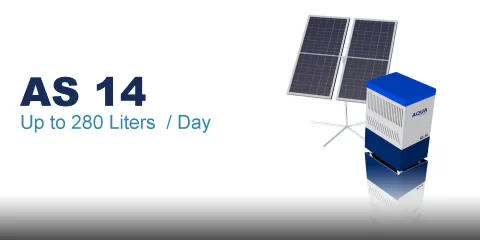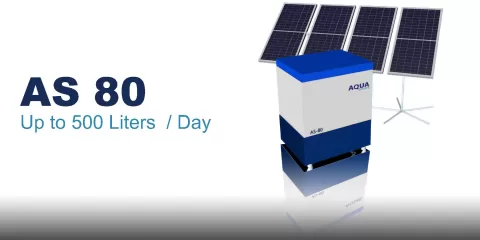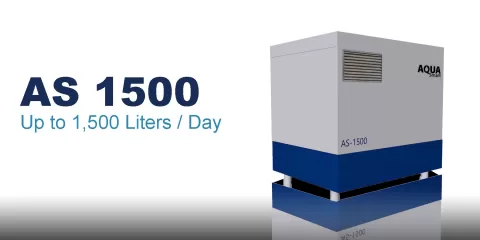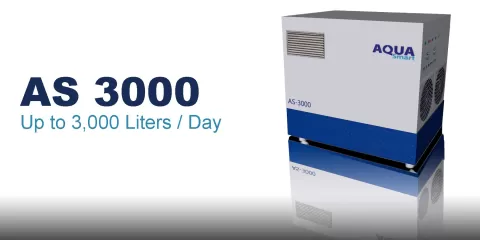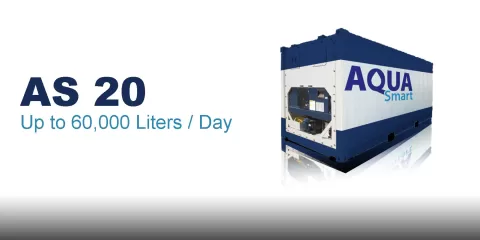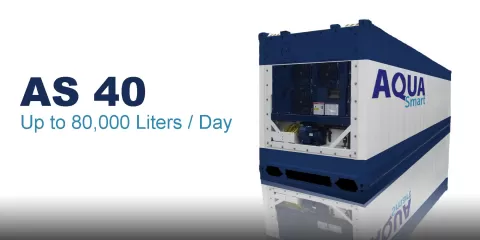The AquaSmart technology is an innovative liquid cooling method, this innovation allows for higher cooling efficiency that allows sub-zero refrigeration at minimal power input. This allowed us to use this innovation in upgrading traditional cooling and refrigeration systems as well as develop our own water generation system.
This groundbreaking solution leverages the principles of refrigeration technology and creative engineering to address the pressing global challenge of water scarcity. AquaSmart's core innovation lies in its utilization of liquid cooling instead of the conventional method of directly cooling using Freon gas.
The technology implements thew use of large size industrial radiators that have a large surface area as well as a high thermal conductivity, by cooling the surface below the atmosphere dew point, this allows for the collection of humidity in the atmosphere in the form of water droplets(dew), which is collected by the machine accordingly.
By utilizing our patented advanced cooling system, the system operates in sub-zero temperatures which form ice crystals and creates a solid ice on the condonation surfaces, which allows for an efficient water condensation. This method ensures optimal water harvesting, even in regions with low atmospheric humidity.
The technology also incorporates a control unit with a thermostat and timers. The thermostat monitors and regulates the compressor's operation, optimizing power consumption. The timers control the cycle of the coolant pump, maintaining the coolant's sub-zero temperature in the canister and facilitating the melting of accumulated ice on the radiators.
Water Generation from the Atmosphere
The amount of water available in the air is dictated by humidity levels, temperature, and air pressure, all of which influence the efficiency of atmospheric water generation. Below is a detailed numerical analysis of the science behind AquaSmart’s water extraction capabilities:
- Atmospheric Water Availability
The Earth’s atmosphere contains an estimated 12,900 cubic kilometers (12.9 trillion metric tons) of water at any given time in the form of water vapor.
This is nearly six times the volume of all rivers combined and represents a continuous, renewable resource.
Even in arid climates, where relative humidity can be as low as 20%, there is still extractable moisture in the air.
- Water Extraction Efficiency Based on Humidity & Temperature
AquaSmart’s water generation efficiency depends on Relative Humidity (RH%) and Temperature (°C):
| Humidity Level (%) | Water Yield (Liters per m³ of Air at 25°C) | Extraction Efficiency |
| 100% RH | 23g of water per m³ of air | High Efficiency |
| 80% RH | 18.4g of water per m³ of air | Optimal Efficiency |
| 60% RH | 13.8g of water per m³ of air | Moderate Efficiency |
| 40% RH | 9.2g of water per m³ of air | Reduced Efficiency |
| 20% RH | 4.6g of water per m³ of air | Limited Efficiency |
At an average 60% RH and 25°C, AquaSmart can extract 13.8g of water per cubic meter of air.
In a 24-hour operation, with 10,000 cubic meters of processed air, this equates to 138 liters per day from a single unit.
Scaling up, an industrial AquaSmart system processing 1,000,000 cubic meters of air daily can generate 13,800 liters (13.8 metric tons) of water per day.
- Energy Consumption & Efficiency
AquaSmart prioritizes efficiency through low-energy cooling and condensation:
The Energy Efficiency Ratio (EER) of the system varies between 3.5 – 5.0 L/kWh (liters per kilowatt-hour), meaning each kWh of electricity generates 3.5 to 5 liters of water.
For a system producing 500 liters per day, the estimated energy consumption would be 100 – 140 kWh/day, depending on local climate conditions.
Larger units (e.g., industrial-scale 10,000L/day models) optimize power usage through smart energy recovery and passive cooling systems.
- Scalability & Deployment Potential
A single household AquaSmart unit can provide up to 50 liters/day, sufficient for drinking and essential use for a family of four.
A modular industrial AquaSmart system can generate 3 metric tons of water per day, capable of supplying 1,500+ people with potable water.
With strategic placement, 1,000 industrial AquaSmart units could supply over 1.5 million people with clean drinking water annually.
AquaSmart taps into the Earth’s vast, renewable atmospheric water reserves, converting airborne moisture into a reliable water source for households, businesses, and industries. By leveraging humidity, smart cooling technologies, and scalable modular designs, AquaSmart represents a highly efficient and sustainable water solution—providing clean drinking water while minimizing environmental impact.
Operating Under Pressure
How Increased Ambient Pressure in AquaSmart’s Condensation Chamber Enhances Productivity
Pressurized Condensation = Higher Yield & Efficiency
By increasing the internal pressure within the condensation chamber, AquaSmart dramatically enhances its water production efficiency. This approach:
Doubles the available water content per air volume
Reduces energy needed per liter of water produced
Maintains high performance even in low-humidity environments
Optimizes footprint, making systems more compact and scalableThis technological advantage makes AquaSmart a powerful, efficient, and scalable solution for water generation, even in some of the world’s most challenging climates.
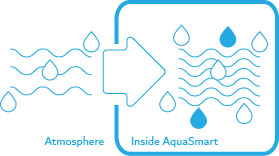
AquaSmart’s innovative high-pressure condensation chamber is a game-changer in atmospheric water generation. By maintaining an internal ambient pressure higher than the external atmospheric pressure (e.g., 2 bar external ambient pressure), the system significantly boosts water production efficiency. Here’s a detailed breakdown of how this works:
- Increased Air Density = More Water Extraction Per Cycle
At higher pressures, air molecules are compressed, increasing the absolute humidity (water content per unit volume of air).
At 2 bar (twice normal atmospheric pressure), the air density is doubled, meaning the same intake volume contains twice as many water molecules compared to air at normal atmospheric pressure.
This maximizes water extraction per cycle, making the condensation process much more productive.
- Faster Cooling and Condensation Rate
Compressed air cools more efficiently because heat transfer is enhanced under high pressure.
As a result, water vapor reaches the dew point more quickly, leading to faster and more efficient condensation.
This reduces the energy required per liter of water extracted, improving the system’s energy efficiency (liters per kWh).
- Enhanced Control Over Dew Point & Condensation Efficiency
The dew point is the temperature at which water vapor condenses into liquid. In a normal system, the dew point depends on external temperature and humidity, but AquaSmart’s pressurized chamber artificially increases humidity concentration, lowering the required dew point temperature.
This means that even in low-humidity environments (e.g., 20-30% RH), condensation remains efficient, making the system viable in arid regions where traditional atmospheric water generators struggle.
- Greater Productivity in a Smaller Footprint
Because pressurized air holds more water vapor per unit volume, the system extracts more water in less space.
This allows AquaSmart to reduce the size of heat exchangers and cooling components, making the unit more compact yet highly productive.
The higher air density also reduces the need for excessive airflow, cutting down on fan energy consumption and making the system more power-efficient.
- Overcoming Low-Humidity Limitation
Traditional atmospheric water generators perform best at 60-80% humidity, struggling below 40%.
AquaSmart’s pressurized system compensates for low ambient humidity by artificially increasing absolute humidity in the chamber.
This means that even in desert-like conditions (20-30% RH), the system can maintain water extraction rates comparable to a 50-60% RH environment in conventional systems.
- Energy Efficiency & ROI Improvement
By extracting more water per unit of air intake, AquaSmart improves the Liters per kWh ratio, reducing operational costs.
Businesses and communities using AquaSmart recover investment costs faster due to higher water yield per day with the same energy input.
Ice Cool
A Perfect Combination for Maximum Water Yield By combining:
-10°C ultra-cold liquid cooling for enhanced freezing-based condensation,
A pressurized chamber for higher air moisture content, and
Self-regulating ice-melting cycles
AquaSmart is able to outperform traditional AWGs in both humid and dry climates, ensuring high water productivity, minimal energy consumption, and a continuous supply of water—no matter the weather conditions.
How AquaSmart’s -10°C Liquid Cooling and Pressurized Chamber Boost Productivity—Even in Dry Climates.
AquaSmart›s advanced -10°C liquid cooling system, combined with its pressurized condensation chamber, significantly enhances water generation efficiency. This dual-technology approach allows AquaSmart to extract water even in dry climates where traditional atmospheric water generators (AWGs) struggle. Here’s how:
- Ice Formation Enhances Condensation Efficiency
At -10°C, the condensation radiators operate well below the dew point temperature, allowing water vapor to freeze upon contact rather than just condense into liquid water.
This ice formation is critical for productivity because:
- The frozen water layer continues to capture additional moisture from passing air, increasing condensation efficiency.
- Ice acts as a natural water storage, melting slowly to provide a continuous water supply even when humidity fluctuates.
- The freezing process extracts more moisture per cycle compared to liquid-only condensation, boosting yield per unit of air processed.
2. Pressurized Chamber Multiplies Water Extraction
The pressurized condensation chamber (operating at 2 bar external ambient pressure) compresses incoming air, increasing its absolute humidity.
Higher humidity means more water molecules per cubic meter of air, making condensation more efficient—even in arid conditions.
Since the chamber is already dense with water vapor, the freezing effect at -10°C captures even the smallest amounts of moisture, ensuring productivity even in low-humidity environments (20-30% RH).
3. Improved Performance in Dry Climates
In dry regions, traditional AWGs suffer because lower humidity means less available water for condensation.
AquaSmart overcomes this challenge by:
- Artificially increasing water vapor concentration via the pressurized chamber.\
- Lowering the dew point requirement with -10°C cooling, allowing condensation to happen even at low humidity levels.
- Maintaining a productive water cycle, as ice buildup ensures steady water supply, even if air moisture fluctuates throughout the day.
4. Energy Efficiency and System Optimization
Because freezing is more effective than simple condensation, AquaSmart extracts more water per kWh of energy used.
The cycling between freezing and melting phases ensures:
- Consistent water output even when external humidity levels drop.
- Minimal downtime, as the system does not rely solely on external humidity peaks to produce water.
- Lower energy consumption per liter of water produced, increasing overall efficiency.
- Self-Regulating Water Production
Ice formation allows the system to store water internally, meaning:
- It can release water slowly even when conditions aren’t ideal, ensuring a steady flow.
- The system maintains efficiency without requiring continuous high humidity, making it viable for desert and arid environments.

